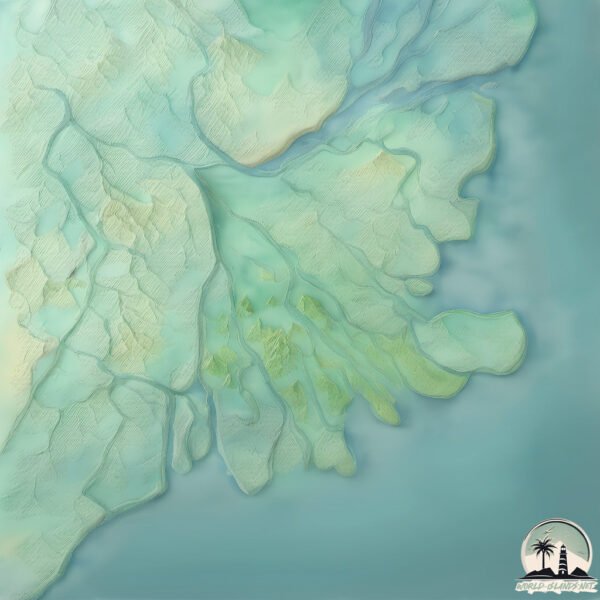Mahakam River Delta

Welcome to Mahakam River Delta, a Tropical island in the Makassar Strait, part of the majestic Pacific Ocean. This guide offers a comprehensive overview of what makes Mahakam River Delta unique – from its geography and climate to its population, infrastructure, and beyond. Dive into the details:
- Geography and Size: Explore the island’s size and location.
- Climate and Weather: Weather patterns and temperature.
- Topography and Nature: Uncover the natural wonders of the island.
- Infrastructure and Travelling: Insights on reaching, staying, and making the most of your visit.
Geography and size of Mahakam River Delta
Size: 12.063 km²
Coastline: 24 km
Ocean: Pacific Ocean
Sea: Makassar Strait
Continent: Asia
Mahakam River Delta is a Medium Island spanning 12.1 km² with a coastline of 24 km.
Archipel: Greater Sunda Islands – A group of large islands in Southeast Asia, including Borneo, Sumatra, Java, and Sulawesi, known for their rich biodiversity and cultural diversity.
Tectonic Plate: Birds Head – Also known as the Bird’s Head Plate, it is a small tectonic plate in the vicinity of the Bird’s Head Peninsula in West Papua. The plate is noted for its interactions with the Pacific, Australian, and Philippine Sea plates, contributing to the geological complexity of the region.
The geographic heart of the island is pinpointed at these coordinates:
Latitude: -0.66116372 / Longitude: 117.38496491
Climate and weather of Mahakam River Delta
Climate Zone: Tropical
Climate Details: Tropical Rainforest Climate
Temperature: Hot
Climate Characteristics: This climate is typified by heavy rainfall throughout the year, high humidity, and consistently high temperatures, leading to lush rainforests and rich biodiversity. Seasonal temperature variations are minimal.
Topography and nature of Mahakam River Delta
Timezone: UTC+08:00
Timezone places: Australia/Perth
Max. Elevation: 15 m
Mean Elevation: 5 m
Vegetation: Mangrove Forest
Tree Coverage: 53%
The mean elevation is 5 m. The highest elevation on the island reaches approximately 15 meters above sea level. The island is characterized by Plains: Flat, low-lying lands characterized by a maximum elevation of up to 200 meters.
Dominating Vegetation: Mangrove Forest
Found in coastal areas and river deltas, these unique wetland ecosystems are adapted to saline conditions and are crucial for coastal protection and biodiversity. Mahakam River Delta has a tree cover of 53 %.
Vegetation: 15 vegetation zones – Exceptionally Diverse Island
With more than ten vegetation zones, this island ranks among the most ecologically varied, resembling a miniature continent. Its incredible range of habitats, from peaks to valleys, fosters a diverse mosaic of life that is unparalleled.
Infrastructure and Travelling to Mahakam River Delta
The mean population of Mahakam River Delta is 35 per km². Mahakam River Delta is Gently Populated. The island belongs to Indonesia.
Indonesia is classified as Emerging region: MIKT: Mexico, Indonesia, South Korea, and Turkey – Economies recognized for their development potential and emerging market status. The level of income is Lower middle income.
The name of the island resonates across different cultures and languages. Here is how it is known around the world: Arabic: بورنيو; German: Borneo; Spanish: Isla de Borneo; French: Bornéo; Portuguese: Bornéu; Russian: Калимантан; Chinese: 婆罗洲
Continuing your journey, is the next notable island, situated merely km away.
Mahakam delta Fieldwork



 gusung parimanu, delta mahakam, kalimantan timur
gusung parimanu, delta mahakam, kalimantan timurDoes the island have a public airport with scheduled flights? no.
There is no public and scheduled airport on Mahakam River Delta. The nearest airport is Aji Pangeran Tumenggung Pranoto International Airport, located 23 km away.
Does the island have a major port? no.
There are no major ports on Mahakam River Delta. The closest major port is SENIPAH OIL TERMINAL, approximately 13 km away.
Please note: The data used here has been primarily extracted from satellite readings. Deviations from exact values may occur, particularly regarding population density, the height of elevations, land area, and coastline measurements. The latter refers to average values at mean high tide.
